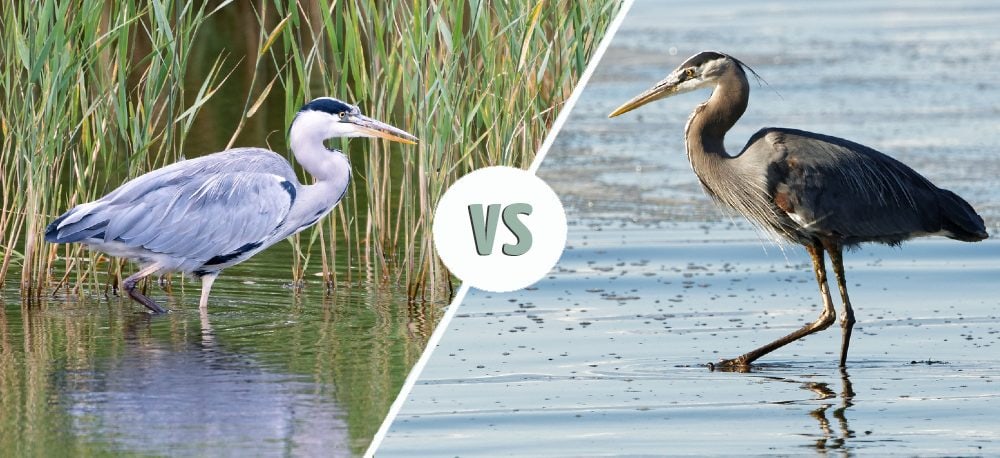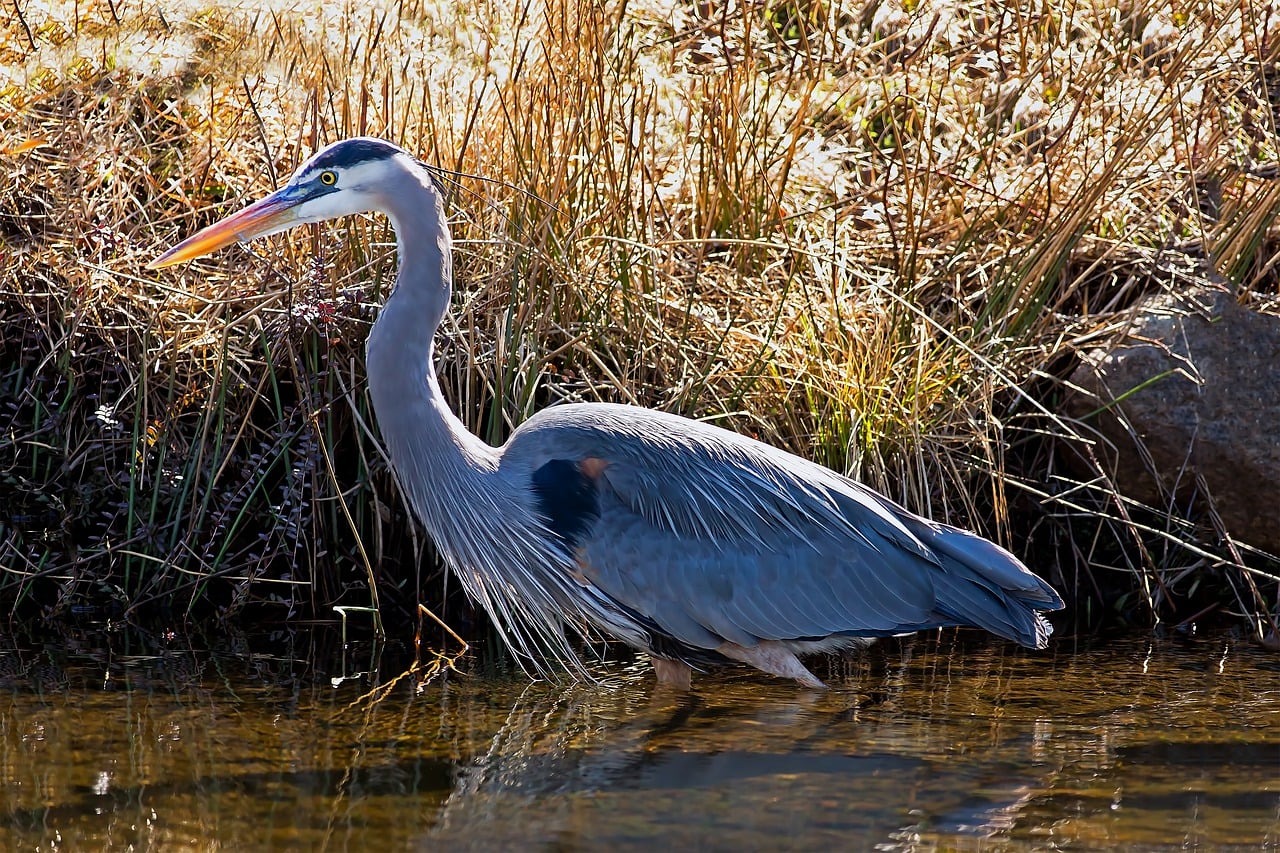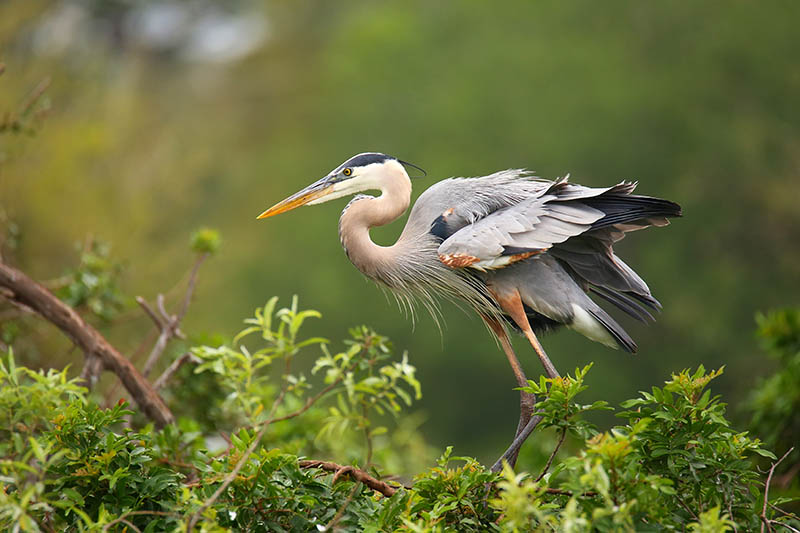Grey Heron vs Great Blue Heron: How To Tell the Difference
Last Updated on

The grey heron and great blue heron are two standouts in the Ardeidae family of birds. Often described as majestic, the grey heron and great blue heron are a delight to see in person and worth seeking out. However, one challenge for bird watchers is telling the two species apart as they share several traits, look remarkably similar, and share similar tastes in habitats. If that’s you, and you’re searching for information on how to tell the exquisite-looking birds apart, read on. We’ll examine their differences and how to spot them below, as well as some fascinating facts about both species.

Visual Differences

At a Glance – Great Blue Heron vs. Grey Heron
- Origin: North America
- Height: 45–54 inches
- Length: 36–54 inches
- Wingspan: 66–79 inches
- Weight: 8 pounds
- Lifespan: 15 Years (Oldest recorded: 25 years)
- Domesticated: No.
- Origin: Europe, Asia, Parts of Africa
- Height: 40 inches
- Length: 33–40 inches
- Wingspan: 60–77 inches
- Weight: 4.5 pounds
- Lifespan: 5 Years (Oldest recorded: 24 years)
- Domesticated:

Great Blue Heron Overview

Characteristics & Appearance
The first thing you notice about the great blue heron (Ardea Herodias) is that they’re incredibly tall, with flight feathers that are deep blueish gray. Their flanks are rust-brown with black stripes, and their necks are dark blueish gray with white and black striping down the entire front, which tends to stand out much more on the grey heron. The great blue heron’s face and most of its head are white except for a black crown over the eye that extends back to its plume. Their bill is pumpkin orange during the breeding season but pastel yellow the rest of the year.
Habitat and Territory
Habitat and territory are two aspects where the great blue heron and the grey heron share the same attribute: both species love marshlands and wetlands. The great blue heron can be found throughout the United States, in southern Canada, Mexico, and northern Central America. They hunt around riverbanks in estuaries and ponds and are occasionally seen along coastal shorelines. The great blue heron has also been known to feed in open farmland and large meadows.

Diet
The diet of the great blue heron, a piscivore, is similar to the grey heron in that they eat a lot of fish and can often be seen with large fish in their bills. They like crabs, muskrats, reptiles, frogs, and other amphibians. Great blue herons stand incredibly still and, when they see prey, strike it quickly with their bill. They also will take advantage of anything edible they find floating. They have been seen eating smaller birds, but fish is their food of preference.
Breeding
The great blue heron breeds in large colonies, often mixed with other bird species. The male chooses the nesting site but the female, after their courtship, makes the nest with materials collected by the male. What’s interesting about where they make their nest is that it can vary significantly.
If they know the area is safe, great blue herons will nest on the ground but have also been seen nesting high in trees. Great blue herons will also make their nest in low-lying shrubs that hang over the water, and it’s usually quite large, which isn’t surprising considering their size.

The female great blue heron typically lays three to five eggs but can lay as many as seven. Both parents incubate the eggs and, when they hatch, feed their young. They usually have one brood per season, but in southern parts of North America, Mexico, and Central America, they will often have two. Great blue heron chicks become fledglings between 70 to 90 days after hatching. Although great blue herons remain monogamous while breeding, they choose a different mate every season.

Grey Heron Overview

Characteristics & Appearance
Like the great blue heron, grey herons are social birds often found in large flocks, but they like their alone time when hunting food. The grey heron has a medium gray body, wings, and a white head and neck. They also have a black stripe that extends down from their eye. Their flanks usually have a black border and white lines on the back of their feathers. The grey heron’s bill is yellow and pink and is also quite powerful. They are tall birds but not nearly as tall as the great blue heron.
Habitat and Territory
Like great blue herons, grey herons are very much at home in wetlands like marshes, estuaries, flooded grasslands, mangroves, swamps, and anywhere there is shallow water for hunting. There they will stand on one leg, sometimes for what seems like hours, waiting for food to swim, crawl, or hop past until they quickly strike.
The bird lives in Asia, Africa, and Europe. In northern Europe, they often migrate south, but most grey heron populations stay put year-round. Although they tend to stay near the coast, you can spot them in the mountains, the desert (looking for beetles and lizards), and even on farms and pastureland.

Diet
Grey herons are piscivores like great blue herons and eat a wide variety of fish. However, depending on where they are and the time of year, they will also eat mussels, frogs, shrimp, snakes, smaller birds and rodents, and several plants. If you find them in desert areas, they usually look for lizards, beetles, and other small animals, including rodents.
Breeding
The grey heron is what researchers call “serially monogamous,” which means that breeding pairs stay together for a single season and then find new mates the following year. Like great blue herons, grey herons also breed in large flocks. The flocks seek water and trees and nest high to protect themselves from predators; it’s very rare to find them nesting at ground level. Grey herons often reuse their nests, and because of this, their nests can become very large over the years. Like the great blue heron, the male finds the nesting materials while the female builds the nest. Both parents incubate the three to five eggs, and when they hatch, both feed the chicks. Chicks become fledglings at about 50 days, but they stay with their parents for 2 to 3 weeks afterward.


What Are the Differences Between Great Blue Herons and Grey Herons?
One of the most significant visual differences between the grey heron and the great blue heron is their size. Grey herons are shorter, weigh less, and have considerably shorter necks than the great blue heron. For example, a great blue heron adult male weighs about 30% more than its grey heron counterpart, and its neck can be twice as long.
Also, the great blue heron’s neck is more of an “S” shape, while the grey heron’s is straighter. What’s fascinating, however, is that their wingspans are almost equal in length!
Another distinction between the two species is that great blue herons have an extensive black cap on their head while grey herons are gray to dark gray. The neck of the great blue heron is substantially longer and more curved than the grey heron, and they have longer plumage on their chest that sticks out and away from them when they stand. Speaking of standing, the great blue heron has orange legs during their breeding season, while the grey heron’s legs remain brown throughout the year.
The easiest way to tell which bird you’re observing is that great blue herons live in and around North America, while grey herons are found in Europe, Asia, and Africa.

Can You Take These Birds Home?
Neither the great blue heron nor the grey heron have been domesticated and are rarely (if ever) kept as pets. Both are gorgeous, majestic birds and a delight to see, but keeping them in your yard or on your property is illegal.

Final Thoughts About the Grey Heron vs. Great Blue Heron
The grey heron and great blue heron are marvelous creatures with long necks and legs, elegant feathers and coloring, and massive wingspans that are a joy to see in flight. While they have many similarities, the most significant differences between the great blue heron and the grey heron are their territory and size.
The former calls North America, Canada, and Central America home, while the latter lives Asia, Europe, and Africa home. Also, the great blue heron is much larger, taller, and has a longer neck than the grey heron. No matter which you are lucky enough to spot in the wild, you’ll be glad you did since they are both magnificent birds.
Featured Image Credit: (L) Mark Robert Paton, Shutterstock | (R) Sue Harper Photography, Shutterstock
About the Author Greg Iacono
Greg Iacono is a self-taught writer and former chiropractor who, ironically, retired early due to back problems. He now spends his time writing scintillating content on a wide variety of subjects. Greg is also a well-known video script writer known for his ability to take a complex subject and make it accessible for the layperson.
Related Articles:
How to Collimate Binoculars: 9 Expert Tips
How to Clean a Refractor Telescope: Step-by-Step Guide
How to Clean a Telescope Eyepiece: Step-by-Step Guide
How to Clean a Rifle Scope: 8 Expert Tips
Monocular vs Telescope: Differences Explained (With Pictures)
Can You Use Binoculars to Look At Stars? How to Choose the Right Pair
How to Choose Binoculars for Bird Watching: 10 Expert Tips
Holy Stone Drone Review of 2024 – Pros, Cons, and Verdict
